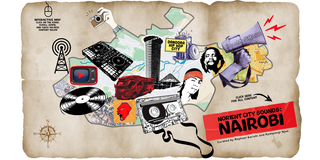Artists using sounds to showcase Nairobi

A map of Nairobi showing the various contents in the virtual exhibition by Norient City Sounds.
Of course the pandemic made us rethink everything about how we see life. How we see the future, how we sleep, how we work, and how, of course, we consume art. When we were submerged in the thick of isolation, art, leisure, entertainment, whatever you want to call the powerhouse that is the creative industry, is what got us through it all.
Two creatives in Nairobi adapted to this in a particularly unique way: by giving us what flights could not – an exploration around the city of Nairobi.
Ah, yes. Nairobi. The city in the sun. The place of cool waters – though now so backed up with traffic and noise, that listening through to hear what it used to be proves even more difficult than imagining what it could have been.
It is listening, that then gave these two artists the means with which to transport the feeling of Nairobi. If you’ve never been in this city, almost the first thing you notice, after the dust, is the noise. The brouhaha. The cacophony of five million people heaving, hawing, trying to make a living, trying to survive. They should say if you can make it in Nairobi (and if you can drive in Nairobi!) then you can make it anywhere.
These two artists are Raphael Kariuki aka DJ Raph, who is an electronic musician, producer and DJ from Nairobi, Kenya. This DJ, in pursuit of something different from your regular, started a weekly listening event for underground and electronic experimental music called the MIST, in Westlands.

Raphael Kariuki, aka DJ Raph, is an electronic musician, producer and DJ.
And then there’s Kamwangi Njue, who first caught his eye because of his eclectic taste in music. Kamwangi is a multidisciplinary artist, writer, and experimental beatmaker. Together, these two partnered with Norient (an audio-visual gallery and a community (of practice) for the sound of the world for contemporary music, quality journalism, cutting-edge research, projects and events) to produce the first City Sounds edition of its kind: the Norient City Sounds: Nairobi Edition.
And how, exactly, do you explore a city – not with your hands and feet, and eyes and mouth, but with your ears? You make it an audio-visual digital exhibition, of course. When you open up the landing page of this exhibition, you will see Nairobi represented in the cacophony I have described above: the chaos of the matatu industry, the fire of our political past, and even the slightly scandalous representation of the most identifiable building in Nairobi, KICC, said to be modelled after a donkey’s penis!
The cacophony is a living, breathing table of contents, that opens into a world beyond the seeing eye. When you click on the icon that is a cassette (how quaint!), for example, you are led to a mixtape of conscious music in Nairobi, described thusly:
"…this selection here tries as much as possible to identify them through their unifying act of Sheng poetics. Together with the radical critique of the government, police brutality, corruption, and institutions, other things appear as well: the violence of poverty and gender, mental, and body health, and human relationships, ethics, and radio that won’t play these songs…"
This mixtape features some who you would expect, and some who you wouldn’t – like Kitu Sewer & MC Mutant, G-DASH, Ndoch (because if anyone was and is Nairobi, it is Kitu Sewer) and of course, K-South, who put so many words and feelings to the city’s words and feelings; and then, from far left, names you may not be familiar with like Veryl Mkali Wako and Trabolee of the new school.
Further exploration below the interactive map are articles exploring various sound examples of the city as well, from a podcast episode that talks to a young and explosive producer (Victor Munyasya) to Gengepress, a compilation album by the two artists mixed and remixed after conversations with several of Nairobi’s most influential, or more, less mainstream, than most; such as Blinky Bill, who has long been part of the alternative group Just A Band, responsible for huge crossover hits like Ha He and Probably for Lovers.
Blinky Bill shares a deep-felt and poignant reminder of hope, in this minimal sketch.
"And when I see Kenyans who are exceptional, they’re really exceptional by any standard, that keeps me motivated that there’s people who’ve not lost complete faith in the system and they’re operating outside the system and trying to make things work."
Nairobi Conscious is trying to have a little bit of it all, from podcasts (Chapatis in Hip Hop City), to essays (Nairobi Now: The Freedom of Love and the Love of Freedom), compilation albums (Ten Video Clips from Nairobi) to interviews (Urban Legends: Kamaa of Kalamashaka), to colour and light, to handing over this light to the next generation.
It does lean heavily on the sheng representations found in this city, in a bid to really explore the roots of what expression and self-expression looks like after we decolonize our minds; but in doing that, it also gives extensive insight into the fundamentals of an audio experience looks like of Nairobi, of what it looks like – sorry, sounds like – to be here. It gives you a starting block, and then it tells you to go find it yourself. Much like Nai.





